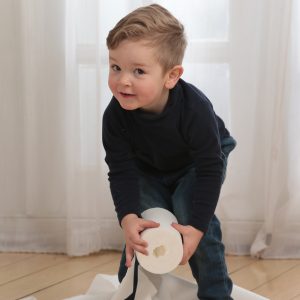Organic Care Wipe/Nappy Liner
Good to skin, good to nature
Features
- Ideal for making your own wet wipes
- Cellulose-based viscose fleece
- From sustainable forestry
- Without chemical additives or binders
- Biodegradable without residues
- Regionally produced in Germany and Austria
- Particularly soft, tear-resistant and absorbent
- No use of petroleum-based plastic packaging
- Practical dispenser system for the changing table
- Single sheet approx. 15.5 x 30 cm
- 70 sheets per pack

Product description
Description
Our tear-resistant liner is inserted into the nappy, collecting the majority of the waste. Nappies and inserts therefore stay clean for longer and last longer too. The nappy liner is very kind to skin, soft, and super absorbent. The liner is also ideal for producing your own wet wipes. Even liquids can be wiped up quickly and easily using the nappy liner.
Application:
Simply lay a sheet of the nappy liner as the top layer in your baby’s nappy. If a sheet is too short or too long, then simply use two sheets or cut the liner to suit. The perforations we have added are only a suggestion, which should cover most nappies and nappy systems up to size 4.
Material and care advice
Material: 100% Viscose
Care Advice:
- The insert is free from chemical binders and biodegradable.
- But it can also be disposed of in household waste and be recycled thermally.
- Do not dispose of in the toilet.
Manufacture: The cellulose comes from sustainable forestry. We pay attention to regional regional manufacturing and produce our fleece in Germany and Austria.
Usage: The tear-resistant nappy fleece catches the coarsest dirt easily and safely. and safely. Cloth nappies and liners stay clean longer and are protected.
Shelf life: The practical dispenser packaging guarantees that the organic care/diaper nappy fleece arrives undamaged at your home, and we deliberately avoid petroleum-based plastic packaging.
Disposal: The liner can be disposed of in the bio bin and composted or thermally recycled in the be disposed of in the organic waste bin and composted or thermally recycled in the residual waste. Please take the packaging to the appropriate recycling system.
The liner is free from chemical binders and is biodegradable. Please observe the regional disposal guidelines!
If the fleece is soiled by excrement, it must be disposed of in the residual waste disposed of in the residual waste according to the regional guidelines.
Downloads
Tips & Tricks
Why should I make my own wet wipes?
Nowadays, most wet wipes for babies are perfumed. Finding fragrance-free care products is not that easy, but a baby’s skin really only needs water for cleaning and general care in the first few months as it is so sensitive and easily prone to skin irritation. Preservatives, fragrances and colouring agents really should not come into contact with sensitive skin.
By using our organic care wipes/nappy liners, it’s so easy for you to make your own wet wipes. This also means that you will always know what is in your wet wipes and you don’t need to worry at all about any dubious or allergenic ingredients!
How can I make my own wet wipes?
The cellulose liner is particularly tear-resistant in comparison with standard kitchen paper and this makes it ideal for making your own wet wipes.
To do this you can cut the individual cloths to the size you want or use them whole. Simply put the cloths into a bowl with boiled, cooled water. Leave them to soak for a short time and then they are ready! If you want to, you can mix a little bit of oil (coconut, olive, almond) with the warm water beforehand. We recommend that you add approx. one teaspoonful to 250 ml water.
Environmental tip: It is not just our organic care wipes/nappy liners which are ideal for making wet wipes. You can also use our small cotton muslin cloths. The cloths are 30 x 30 cm and can be simply washed in the washing machine after use.
The organic care wipe/nappy liner is too short. What can I do?
If the sheet size of the organic care wipe/nappy liner is not right for your child or nappy system, then please cut the sheets up to suit your requirements. The perforations are only there as a guide. You can easily use two sheets or cut the liner up to suit your needs.

















